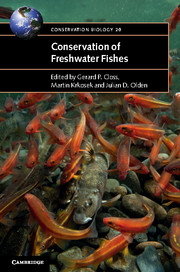Book contents
- Frontmatter
- Contents
- List of contributors
- Preface
- 1 Lost fishes, who is counting? The extent of the threat to freshwater fish biodiversity
- 2 Why are freshwater fish so threatened?
- 3 Climate change effects on freshwater fishes, conservation and management
- 4 Challenges and opportunities for fish conservation in dam-impacted waters
- 5 Chemical pollution
- 6 Multiple stressor effects on freshwater fish: a review and meta-analysis
- 7 Infectious disease and the conservation of freshwater fish
- 8 Non-indigenous fishes and their role in freshwater fish imperilment
- 9 Riparian management and the conservation of stream ecosystems and fishes
- 10 Fragmentation, connectivity and fish species persistence in freshwater ecosystems
- 11 Conservation of migratory fishes in freshwater ecosystems
- 12 Protecting apex predators
- 13 Artificial propagation of freshwater fishes: benefits and risks to recipient ecosystems from stocking, translocation and re-introduction
- 14 Freshwater conservation planning
- 15 Sustainable inland fisheries – perspectives from the recreational, commercial and subsistence sectors from around the globe
- 16 Understanding and conserving genetic diversity in a world dominated by alien introductions and native transfers: the case study of primary and peripheral freshwater fishes in southern Europe
- 17 Maintaining taxonomic skills; the decline of taxonomy – a threat to fish conservation
- 18 Synthesis – what is the future of freshwater fishes?
- Index
- References
17 - Maintaining taxonomic skills; the decline of taxonomy – a threat to fish conservation
Published online by Cambridge University Press: 05 December 2015
- Frontmatter
- Contents
- List of contributors
- Preface
- 1 Lost fishes, who is counting? The extent of the threat to freshwater fish biodiversity
- 2 Why are freshwater fish so threatened?
- 3 Climate change effects on freshwater fishes, conservation and management
- 4 Challenges and opportunities for fish conservation in dam-impacted waters
- 5 Chemical pollution
- 6 Multiple stressor effects on freshwater fish: a review and meta-analysis
- 7 Infectious disease and the conservation of freshwater fish
- 8 Non-indigenous fishes and their role in freshwater fish imperilment
- 9 Riparian management and the conservation of stream ecosystems and fishes
- 10 Fragmentation, connectivity and fish species persistence in freshwater ecosystems
- 11 Conservation of migratory fishes in freshwater ecosystems
- 12 Protecting apex predators
- 13 Artificial propagation of freshwater fishes: benefits and risks to recipient ecosystems from stocking, translocation and re-introduction
- 14 Freshwater conservation planning
- 15 Sustainable inland fisheries – perspectives from the recreational, commercial and subsistence sectors from around the globe
- 16 Understanding and conserving genetic diversity in a world dominated by alien introductions and native transfers: the case study of primary and peripheral freshwater fishes in southern Europe
- 17 Maintaining taxonomic skills; the decline of taxonomy – a threat to fish conservation
- 18 Synthesis – what is the future of freshwater fishes?
- Index
- References
Summary
INTRODUCTION
Species, however defined, are the generally accepted unit of biology, including in conservation biology where it is more conventional to consider elements in terms of landscape units, ecosystems or communities (Mace, 2004). Here we consider how a general decline in systematics and taxonomy, the science dealing with the identification, description, naming and classifying of organisms, might affect fish conservation (Reid, 2010).
The link between species and conservation has many facets and implications, all of which have changed over time as the paradigms of both systems themselves have changed. The one constant that a ‘species’ has for conservation is that of linkage and communication, of being the instrument through which conservation issues are brought into a common understanding for different audiences. The iconic nature of certain species linked to conservation illustrates this point – giant pandas, rhinos, elephants, tigers, the blue whale or, more relevant to this chapter, species like golden trout, Atlantic salmon, sturgeon, Tennessee darter, coelacanth, Australian lungfish and Asian arowana – all have clear conservation connotations. In every case, the icon connects directly to an environment or ecosystem and threats to its existence, and critically to the human dimensions of its conservation needs. Were it not that fish and fisheries are of major economic and cultural importance (Welcomme et al., 2010), this situation might not be considered that serious, but fishes are key components of aquatic ecosystems and are both an essential food resource as well as a source of other products. They also play a major cultural role, from aesthetics to pets and leisure, in the lives of millions of people (Reid et al., 2013).
Their taxonomy is thus critical to recognise the threats to their existence and the steps required to conserve them. It is our contention, therefore, that conservation is all about ‘human’ concerns and actions, and, as such, taxonomy is a critical component in the process. A ‘taxonomic impediment’ (or insufficient taxonomic expertise) has been raised as a problem for understanding the extent of the biodiversity crisis that currently faces society. As represented in Figure 17.1, taxonomic capacity has been declining and conservation demand clearly increasing, particularly under obligations to international directives and conventions (e.g. Convention on Biological Diversity, Rio+20, the European Habitats and Water Framework Directives), and drives to protect landscapes and habitats.
- Type
- Chapter
- Information
- Conservation of Freshwater Fishes , pp. 535 - 562Publisher: Cambridge University PressPrint publication year: 2015
References
- 3
- Cited by



